

Easter Vigil Homily of Pope Francis in St. Peter's Basilica
Salt + Light Media
Saturday, March 31, 2018

We began this celebration outside, plunged in the darkness of the night and the cold. We felt an oppressive silence at the death of the Lord, a silence with which each of us can identify, a silence that penetrates to the depths of the heart of every disciple, who stands wordless before the cross. These are the hours when the disciple stands speechless in pain at the death of Jesus. What words can be spoken at such a moment? The disciple keeps silent in the awareness of his or her own reactions during those crucial hours in the Lord’s life. Before the injustice that condemned the Master, his disciples were silent. Before the calumnies and the false testimony that the Master endured, his disciples said nothing. During the trying, painful hours of the Passion, his disciples dramatically experienced their inability to put their lives on the line to speak out on behalf of the Master. What is more, not only did they not acknowledge him: they hid, they escaped, they kept silent (cf. Jn 18:25-27). It is the silent night of the disciples who remained numb, paralyzed and uncertain of what to do amid so many painful and disheartening situations. It is also that of today’s disciples, speechless in the face of situations we cannot control, that make us feel and, even worse, believe that nothing can be done to reverse all the injustices that our brothers and sisters are experiencing in their flesh. It is the silent night of those disciples who are disoriented because they are plunged in a crushing routine that robs memory, silences hope and leads to thinking that “this is the way things have always been done”. Those disciples who, overwhelmed, have nothing to say and end up considering “normal” and unexceptional the words of Caiaphas: “Can you not see that it is better for you to have one man die for the people than to have the whole nation destroyed?” (Jn 11:50). Amid our silence, our overpowering silence, the stones begin to cry out (cf. Lk 19:40)1 and to clear the way for the greatest message that history has ever heard: “He is not here, for he has been raised” (Mt 28:6). The stone before the tomb cried out and proclaimed the opening of a new way for all. Creation itself was the first to echo the triumph of life over all that had attempted to silence and stifle the joy of the Gospel. The stone before the tomb was the first to leap up and in its own way intone a song of praise and wonder, of joy and hope, in which all of us are invited to join. Yesterday, we joined the women in contemplating “the one who was pierced” (cf. Jn 19:36; cf. Zech 12:10). Today, with them, we are invited to contemplate the empty tomb and to hear the words of the angel: “Do not be afraid... for he has been raised” (Mt 28:5-6). Those words should affect our deepest convictions and certainties, the ways we judge and deal with the events of our daily lives, especially the ways we relate to others. The empty tomb should challenge us and rally our spirits. It should make us think, but above all it should encourage us to trust and believe that God “happens” in every situation and every person, and that his light can shine in the least expected and most hidden corners of our lives. He rose from the dead, from that place where nobody waits for anything, and now he waits for us – as he did the women – to enable us to share in his saving work. On this basis and with this strength, we Christians place our lives and our energy, our intelligence, our affections and our will, at the service of discovering, and above all creating, paths of dignity. He is not here... he is risen! This is the message that sustains our hope and turns it into concrete gestures of charity. How greatly we need to let our frailty be anointed by this experience! How greatly we need to let our faith be revived! How greatly we need our myopic horizons to be challenged and renewed by this message! Christ is risen, and with him he makes our hope and creativity rise, so that we can face our present problems in the knowledge that we are not alone. To celebrate Easter is to believe once more that God constantly breaks into our personal histories, challenging our “conventions”, those fixed ways of thinking and acting that end up paralyzing us. To celebrate Easter is to allow Jesus to triumph over the craven fear that so often assails us and tries to bury every kind of hope. The stone before the tomb shared in this, the women of the Gospel shared in this, and now the invitation is addressed once more to you and to me. An invitation to break out of our routines and to renew our lives, our decisions and our existence. An invitation that must be directed to where we stand, what we are doing and what we are, with the “power ratio” that is ours. Do we want to share in this message of life or do we prefer simply to continue standing speechless before events as they happen? He is not here... he is raised! And he awaits you in Gaiilee. He invites you to go back to the time and place of your first love and he says to you: Do not be afraid, follow me. “I tell you, if these were silent, the stones would shout out”.
Related Articles:
Category: Featured, General Posts, Lent and Easter
Tag: Easter and Lent, Easter Vigil Homily, Easter Vigil Mass, Pope Francis Homily, St. Peter's Basilica
Pray with the Pope Reflection – June 2025
Friday, June 13, 2025
 Fr. Edmund Lo, SJ
Fr. Edmund Lo, SJ
In this month of June, the Holy Father invites us to pray that the world might grow in compassion, that each one of us might find consolation in a personal relationship with Jesus, and from his Heart, learn to have compassion on the world.
Chaplaincy: “Divine Coffee” for Students
Tuesday, June 10, 2025
 Gianpaolo Capozzi
Gianpaolo Capozzi
Gianpaolo gives us a behind the scenes look at his upcoming Behold segment on the York University Catholic Chaplaincy.
Pope Leo XIV’s homily for Pentecost Sunday 2025
Sunday, June 8, 2025
 Pope Leo XIV
Pope Leo XIV
On Sunday, June 8, 2025, Pope Leo XIV celebrated Mass for the Jubilee of Movements, Associations, and New Communities and spoke about how the Holy Spirit helps the apostles overcome "their fear, shatters their inner chains, heals their wounds, anoints them with strength and grants them the courage to go out to all and to proclaim God’s mighty works."
Homily of Pope Leo XIV at the Mass for the Jubilee of Families, Children, Grandparents, and the Elderly
Sunday, June 1, 2025
 Pope Leo XIV
Pope Leo XIV
Pope Leo XIV celebrated Mass for the Jubilee of Families, Children, Grandparents, and the Elderly and referred to Pope Francis and mentioned spouses who have been beatified and canonized, like the parents of St. Therese of the Child Jesus.
Looking back on Rerum Novarum
Monday, May 26, 2025
 Matthew Neugebauer
Matthew Neugebauer
Pope Leo XIV chose his name primarily to highlight his most recent namesake Leo XIII, whose "historic encyclical Rerum Novarum addressed the social question" to the challenges of his time. What concerns does the encyclical address? How does it speak to its time? And what has been its legacy 134 years later?
SUPPORT LABEL
$50
$100
$150
$250
OTHER AMOUNT
DONATE










